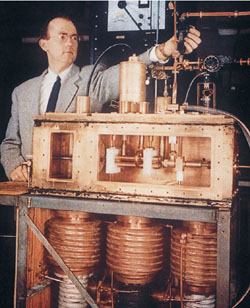Invention of the Maser and Laser

In honor of the World Year of Physics, which commemorates Einstein’s “miraculous year” in 1905, we’re presenting papers from the Physical Review archive related to Einstein’s accomplishments.
The ubiquitous laser, appearing today in supermarket checkout machines, CD players, and eye surgeon’s offices, developed out of the maser, which was first described in Physical Review papers published in 1954 and 1955. The maser–the name stands for “microwave amplification by stimulated emission of radiation”–in turn depended on an insight that came from Albert Einstein almost 40 years earlier. But the path from theory to application was far from straightforward, and it took ingredients from many different disciplines for these theoretically simple devices to achieve practicality.
After World War II, radar scientists looking for ways to generate electromagnetic radiation at wavelengths shorter than one centimeter began collaborating with physicists who wanted to use such radiation to investigate molecular structure. When atomic bonds inside a molecule flip between slightly different forms, they often absorb or emit centimeter- or millimeter-band radiation.
Vacuum tubes and related devices, used in radar, are impractical for producing sub-centimeter wavelength radiation. But in the early 1950s, Charles Townes, then at Columbia University in New York City, had the idea that molecules themselves would make good emitters of the desired wavelengths, if only he could persuade large numbers of molecules to emit en masse.
Recent research came to Townes’ aid. Back in 1916, Albert Einstein had deduced theoretically the existence of stimulated emission–the process by which electromagnetic waves of the right frequency can “stimulate” an excited atom or molecule to fall to a lower energy state and emit more waves. In 1947 Willis Lamb and Robert Retherford, also of Columbia, used stimulated emission to amplify the radiation emitted by hydrogen molecules in order to better measure the frequency of a specific molecular transition [1].
Townes was familiar with microwave engineering techniques and saw a way to go further. If he could assemble a population of excited molecules in a cavity with the right dimensions, radiation emitted by some of the molecules would reflect back and interact with other molecules, causing further stimulated emission. The feedback loop between the cavity and molecules would dramatically amplify the signal, he reasoned.
Townes and his colleagues built the first maser in 1954. They sent a beam of excited ammonia molecules into a resonant cavity. Emission became self-sustaining as radiation from molecules in the cavity stimulated further radiation from the continuously renewed supply of excited molecules. Radiating at a wavelength of a little over one centimeter, the power of this first maser was tiny, some ten nanowatts. But the energy was concentrated in a spectacularly sharp line in the emission spectrum–in other words, the radiation was exceedingly uniform, consisting of a single wavelength with little contamination from other wavelengths.
Many theorists had told Townes his device couldn’t possibly work. Once it did, other researchers quickly replicated it and began inventing variations on it. In 1958 Townes and Arthur Schawlow of Bell Laboratories in New Jersey proposed a system that would work at infrared and optical wavelengths [2] but it wasn’t until 1960 that the first light-emitting maser–which quickly became known as the laser–was constructed [3]. Townes shared the 1964 Nobel Prize in physics for his work on masers and lasers.
Laser development attracted later legal wrangling as various groups fought over patents. But Bernard Burke of the Massachusetts Institute of Technology, who remembers seeing the original maser at Columbia, says that Townes “wasn’t interested in keeping it a secret. It was a nice example of the openness of science.”
–David Lindley
David Lindley is a freelance science writer in Alexandria, Virginia.
References
- W. E. Lamb Jr. and R. C. Retherford, “Fine Structure of the Hydrogen Atom by a Microwave Method,” Phys. Rev. 72, 241 (1947)
- A. L. Schawlow and C. H. Townes, “Infrared and Optical Masers,” Phys. Rev. 112, 1940 (1958)
- T. Maiman, “Stimulated Optical Radiation in Ruby,” Nature (London) 187, 493 (1960)
More Information
laser history from Bell LabsJ. L. Bromberg, The Laser in America: 1950 - 1970 (MIT Press, 1991)


